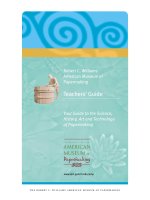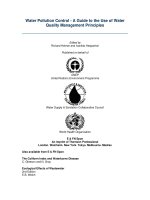Guide to the aquarium of the zoological station at naples
Bạn đang xem bản rút gọn của tài liệu. Xem và tải ngay bản đầy đủ của tài liệu tại đây (22.52 MB, 120 trang )
79
THE LIBRARY
OF
THE UNIVERSITY
OF CALIFORNIA
PRESENTED BY
PROF. CHARLES A. KOFOID
MRS. PRUDENCE W.
AND
KOFOID
r-O
GUIDE
TO THE
OF THE
ZOOLOGICAL STATION AT NAPLES,
FOURTH EDITION
WITH
175
ILLUSTKATIONS.
LEIPZIG
PRINTED BY BREITKOPF & HARTEL
1896.
PART FIRST,
LIST OF THE CONTENTS
OF EACH TANK.
The Aquarium contains only marine animals and
All have been found in the bay of Naples.
plants.
.
In the ensuing list only the most remarkable of the
animals and plants are mentioned; the description given is
purposely couched in colloquial language, being designed
to convey, if possible, in a few words a sufficient impresThe
sion of the animal to lead to its identification.
asterisk (*) before a name signifies that the animal does
not occur at all seasons of the year.
The ascending streams of silvery bubbles in the tanks
are the air drawn in by the sea- water, which is always
being pumped in from dark tanks under the aquarium.
Those animals and plants which are found near the upper
part of a tank, will be seen double, owing to the reflecAll the tanks, but
tion against the surface of the water.
and
Nos.
3,
20,
1,
9,
gain enormously
especially, perhaps,
by being seen in the sunlight between 12 and 2 o'clock.
On the walls of most tanks will be seen the white
tubes of Ciona (compare tank 4), the colonies of Botryllus
(p. 85) and other Compound Ascidians, and a little white
Sponge (p. 55, fig. 159). These grow and breed in the water
of the aquarium, attaching themselves to all suitable surfaces.
In most tanks are swarms of tiny, reddish-brown
In comparing the Fishes with
Opossum-shrimps (p. 74
the figures in the Guide, it must be remembered that in
many species the dorsal fin nearest the head is not visible except when erected (often for defence): notice, as an example.
Labraoc (fig. 55) in tank 10.
The visitor must not rashly
ascribe the power of walking about to Sponges, Tunicates,
.
M356606
Part
first.
which he may
find moving among the rocks
After seeing tank 23 he will be prepared to
trace such vagaries to the little crab which is their cause.
Enquiries of any kind may be made of the attendant.
Anemones,
etc.,
in various tanks.
Tank
Containing exclusively
1.
Nr. 1.
Echinoderms
(p. 63).
Starfishes or "five-fingers", with five (rarely more) creeping
arms: Echinaster
Fig.
1.
(fig.
2),
Astropecten aurantiacus,
size.
red and slender-armed; Luidia
Fig.
2.
p. 65.
Asterias glacialis,
Fig. 3.
Va nat. size. p. 65.
Echinaster sepositus,
Va nat.
Fig. 4.
size.
p. 65.
Ophioderma longicauda,
J
/2
nat. size.
p. 65.
Tank Nr.
6),
fig.
Asterias
much
(fig.
Astropecten
the arms;
3),
1.
and generally with seven arms;
and
large
greenish, with pointed knobs;
larger
(fig.
1),
with points like
little
tusks fringing
Pahmpes, arms webbed, like a
pentagonal
piece of brick-red paper.
2.
3.
Brittle-Stars, with five (rarely six) arms, thinner and more
snake-like than the starfishes, round body like a thick
half-penny (Ophioderma, fig. 4).
Feather-Stars An tedon, fig. 5), mostly holding by their backs
to dead coral-stems (Antipathes, see tank 21) in the centre of
the tank; they are yellow or red and have ten plumed arms.
Antedon rosacea,
Fig. 5.
attached to a branch of Antipathes,
1
-2
4.
nat. size.
1
4
nat. size.
ciliaris,
pag. 65.
Sea-urchins, globular or bun-shaped, covered with spines.
Sphaerechmus fig. 7), generally purplish, spines tipped
white; Echinus (p. 65\ eight to ten inches across, spines
white; Doroddaris (fig. 8), pink with knobs, bearing a
few strong, stick-like spines
Fig.
Luidia
Fig. 6.
pag. 65.
7.
Sphaer echinus gramdaris,
1
-2
nat. size.
p. 65.
-
Fig.
1
/2
S.
Doroddaris papillata,
nat. size.
The
visible,
sucker-feet are not
p. 65.
Part
5.
first.
Sea-CUCUmberS, slug-shaped bodies, covered with pointed
The delicate brown feathery undergrowth will
be seen to be the tentacles of numerous sea- cucumbers
(Cucumaria, fig. 9), adhering to the_ rocks; each has ten
tentacles round its mouth, in crawling they are retracted
suckers.
;
in the larger species (Holothuria,
they are not obvious; Stichopus
long, and
fig.
(fig.
10)
11)
which
is
is
black,
reddish, a foot
flat.
Fig. 9. Cucumaria Planci,
on a stone, with outstretched tentacles,
&Z
Hololhuria tubulosa,
Fig. 10.
Vs nat. size.
p. 65.
Fig.
1 1
.
*/2
Stichopus regalis,
nat. size.
p. 66.
The starfishes, sea-urchins and sea-cucumbers adhere
to the glass or rock by numerous suckers, with which they
crawl (for details v. p. 64), the brittle-stars move by wriggling,
the feather-stars can swim.
Tank Nr.
Tank
3.
2,
Nr.
2.
Fishes: Sea-crow (Corvina, fig. 57), dark -coloured, dark
lower fins. Box (fig. 12 and 13), silver with golden lines.
OUata (fig. 14), silver, with a black root to its tail.
These all feed on the green alga, the lettuce sea-weed
(Ulva lactucd) at the bottom of the tank.
Fig. 12.
1
-2
Box
nat. size.
hoops,
p. 97.
Box
Fig. 13.
*/2
nat-
size.
salpa,
p. 97.
Fig. 14.
Obiata melanura,
V>2
Tank
Nr.
nat. size.
p. 97.
3.
Containing Molllisks.
1.
"Squid or Calmar (Loligo, fig. 15),
and
delicate, transparent,
fish-like, with large eyes, swimdown
the
and
tank.
ming up
Cephalopods
(p.
76).
Part
Fig. 15.
*/2
2.
Snails
or
size.
p. 78.
Sea-hare
78).
(Aplysia, fig.
as large as a man's fist.
^Umbrella (fig. 18).
Triton's
17).
soft black
*Pleurobranchus
16),
19),
i/2
Aplysia limacina,
nat. size.
Pleurobranchus testudinarius,
A
/4
horn (Tritonium,
with red body and yellow horns banded with
Fig. 16.
Fig. 17.
Loligo vulgaris,
na t-
brown lumps
(fig.
fig.
(p.
first.
nat. size.
p. 80.
p. 80.
Fig.
1
Umbrella mediterranea,
8.
1
o
nat. size.
black; shell pointed, shaped like a whelk;
p. 80.
*Tun
(Dolium,
black and white body, rounded shell; Murex
fig. 21), much smaller, with spines; Helmet-shell (Cassis,
fig. 22); Natica (fig. 23).
fig.
20),
Tank
Xr.
Tritonium nodiferum,
Fig. 19.
nat. size.
Fig. 20.
1
:?
Fig. 21.
1
2
Mar ex
nat. size.
brandaris,
p. 79.
3.
p. 79.
Dolium
nat. size.
galea,
p. "9.
Fig. 22.
1
2
nat
Cassis sutcosa,
size.
p. 79.
Part
10
Natica millepunctata,
Yig. 23.
l
/2
nat. size.
first.
Fig. 24.
l
p. 79.
/2
Pecten jacobaeus,
nat. size.
p. 84.
Pholas dactylus,
Fig. 26.
in a stone,
1
/2
Three specimens of
Mytilus eduliSj
Fig. 25.
attached to a piece of rope,
*/2
nat. size.
p. 83.
nat. size.
Two
Fig. 27.
p. 83.
specimens of
Lithodomus dactylus,
within a piece of
1
/2
nat. size.
tufa,
p. 83.
81).
Scallop (Pecten, fig. 24), with flat
Piddock
Edible Mussel (Mytilus, fig. 25).
Lithodomus
both
and
making
(fig. 27),
(Pholas, fig. 26)
holes in rocks or coral reefs.
*EggS Of Mollusks, Of the squid hanging from the dead
coral in long white bags; of the sea-hare fine yellow
of
strings, of the tun ribbons a finger-length broad;
3.
Bivalves
(p.
fluted shell.
Murex large honeycomb-like masses.
The lettuce sea-weed serves as food
for the sea-hares.
Tank Nr.
Tank
11
4.
Nr, 4.
dona (fig. 28), white halfAscidians (Sea-squirts, p. 84).
Phallusia (fig. 29) , knobbed
transparent double tubes.
white mass.
Cynthia (fig. 30), crimson-scarlet, sausageshaped; the mouths of the two tubes can be seen projecting. Colonies of Diazona (fig. 31). Many other kinds.
TubiCOlous worms (see Tank 22), a foot high, like
Heliases (fig. 32), small and
Fishes.
feathery palms.
Four specimens
1
2
Fig. 28.
of Ciona intestinalis.
nat. size.
Fig. 29.
Phallusia mammillata.
p. 84.
1
Fig. 30.
Four specimens of
Cynthia papillosa,
*/2
nat. size.
p. 84.
o'nat. size.
p. 85.
Fig. 31.
A
colony of Diazona violacea,
1
3
nat.
size.
p. 85.
Part
12
first.
black, with deeply forked tail.
*Apogon (fig. 33),
only in summer.
Red algse (Sebdenia and Vidalia),
Sea-weeds.
withered beech- leaves.
green
Fig. 32.
*/2
balls,
the size of a marble to
size.
like
Green alga (Codium
Heliases chromis,
n at.
red,
Fig. 33.
*
p. 96.
Tank
Nr.
bursa], dark
that of a melon.
Apogon rex mullorum,
nat. size.
p. 96.
5.
About ten kinds of Fishes continuously swimming.
Among these prominent by colour or otherwise: Peacockwrasse (Crenilabrus pavo, fig. 34), with blue fins and tail,
Sea-bream (Snapper,
the lips are strongly turned outwards.
a
delicate
coral-pink. Gilt-head (ChrysoPagellus, fig. 37),
phrys, fig. 38), silver, a black smudge on each side behind
its head.
(Larger specimens in Tank 10). Wrasse (Labrus,
shaped more or less like Crenilabrus, green
Toothed-bream (Dentex, fig. 39), silvery, heavy
nose, eyes high, straight mouth with corners down, noti-
fig.
35 and
36),
or mottled.
Fig. 34.
'/2
Crenilabrus pavo,
nat. size.
p. 96.
Tank
ceably
sullen
(Cantharus,
fig. 41),
fig.
fins
Nr.
13
5.
Black Bream
expression.
Sar (Sargus,
40), bluish, with short mouth.
and
aggressive
with dark edges.
Umbrina
(fig.
light undulating stripes.
Labrus
Fig. 35.
1
o
nat. size.
Fig. 36.
Labrus merula,
-
Fig. 37.
V-2
festivus.
p. 96.
size.
p. 96.
Pagellus erythrinus.
nat. size.
p. 97.
42;,
dark with
Part
14
Fig, 38.
*/3
first.
Chrysophrys aurata,
nat
size.
p. 97.
Dentex vulgaris,
Fig. 39.
Vs nat size. p. 97.
Fig. 40.
*/2
Cantharus vulgaris,
nat
size.
p. 97.
Tank Nr.
5,
15
6.
Fig. 41.
Saryus Rondeletii,
Va nat. size. p. 97.
Umbrina cirrosa,
Fig. 42.
Vs nat. size. p. 97.
Tank
Nr. 6.
Fishes.
Scorpaena (fig. 43), ragged and red, with red eyes.
*Lichia (fig. 44), a small kind of mackerel.
Crustaceans. Lobster (Homarus, fig. 45).
Sea-weeds.
Codium elongatum (a green alga
the pink
stone-like balls are calcareous sea-weeds (Corallinse,
cp.
;
tank 21^.
Part
16
Fig. 43.
*/2
Scorpaena porcus,
nat. size.
Fig. 44.
1/2
Fig. 45.
!/3
first.
p. 92.
Lichia glauca.
nat. size.
p. 98.
Homarus
nat. size.
vulgaris,
p. 68.
Tank Nr.
Tank
17
7.
Nr.
7.
Grey Mullet (Mugil, fig. 46), slender and silvery,
the underlip shaped like a W.
Crustaceans (p. 68). Crawfish or Spiny-lobster (Palinurus,
fig. 48), like a lobster without pinching claws.
SpiderFishes.
Fig. 46.
V2
Mugil cephalus,
nat. size.
p. 97.
Fig. 47.
Scyllarus latus,
nat. size.
Palinurus vulgaris,
Fig. 48.
Va nat. size. p. 70.
Guide.
4th ed.
p. 70.









